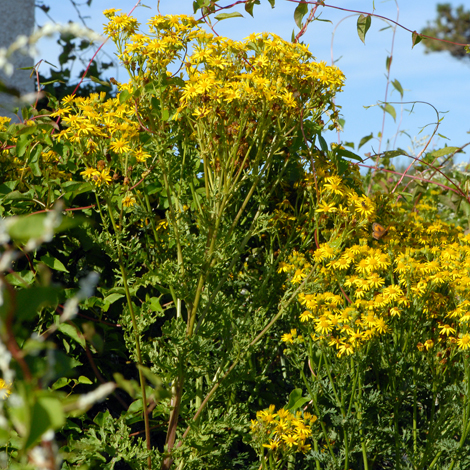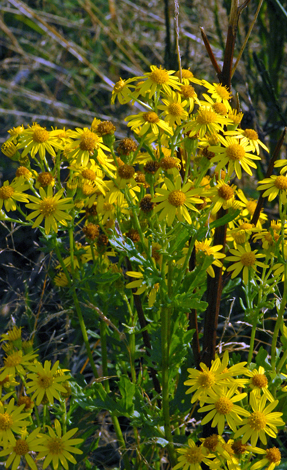Senecio jacobaea Common Ragwort CCC D N


This plant is a British and Irish native found in everywhere from the high hills of Scotland to the outer Hebrides including St Kilda and Shetland. Only on Shetland is it not as common as elsewhere in the country. In other words this Senecio jacobaea is one of the commonest plants in the British Isles. Recognising it isn't quite as simple as you might think because the flowers of many Ragwort species are quite similar. However Senecio jacobaea is a summer flowering biennial/perennial (Stace says it is perennial) plant with deeply dissected leaves and is both erect and reasonably compact compared with the squat, spreading, early flowering Senecio squalidus (Oxford Ragwort) or the tall and more lax-flowered Senecio aquaticus (Marsh Ragwort).
The need for an accurate identification for this plant is because it has two enemies:
(1) a natural one: the Cinnabar moth caterpillar which will eat it to destruction but always identifies Senecio jacobaea correctly and
(2) horse enthusiasts who know that if their horses eat it, it can cause severe liver damage. However they can easily confuse it with other similar Senecio species. Cattle and sheep are also affected by Ragwort poisoning but not as much as horses.
The real need is for the makers of hay to weed this plant out before hay making because unless desperately hungry, horses won't usually eat live Senecio jacobaea in a field of good grass although some horse owners say they sometimes eat the rosettes. Our local farmer puts his horse in field with Senecio jacobaea dotted about but they never touch it because there's plenty of grass. However horses can't seem to taste or sense it in hay and can be poisoned as a result. Understandably horse owning folk can get very worked up about the need to get rid of Senecio jacobaea but perhaps don't quite understand how ubiquitous and resilient it is. It would be slightly easier to decide to get rid of the tides at the seaside or the phases of the moon in my opinion.
One healthy plant of Senecio jacobaea produces thousands of seeds which can be borne, like those of the Dandelion clock, on the wind to destinations far and wide so even if you manage to eradicate it from your own land it could return from plants which grew miles away. It will appear in your best flower bed, your plant pots of sterile uncontaminated soil, your allotment or your lawn. It is supposed to need bare patch of earth to germinate but I don't find that - it regularly appears in the middle of dense patches of lawn - probably because my horse owning farmer friend lets it flower and fruit. Senecio jacobaea seems to be incredibly unfussy where it germinates. So there is absolutely no chance of eradicating it even if that was desirable which it isn't. Since it re-appeared in Britain after the Ice age 12,000 years ago it has become host to communities of native insect species which rely upon it for food and habitat.
From my biased point of view as naturalist and botanist I look at the horses, the Ragwort plant, its ecology and the insects which it supports and ask which of these is the recent introduction? Which is interloper? It's Equus ferus caballus of course so if horse owners don't like Senecio jacobaea on their land then by all means they should weed it out every year but they will find stout opposition from botanists, entomologists and naturalists in general to any campaign aimed at getting rid of one of our beautiful and essential native species from its rightful place as a native plant of the British countryside.
The only way for horse enthusiasts to manage this poisonous plant is the hard way. They must weed it out every year and ensure their suppliers of hay have done the same.
More facts here:
LHS: Red Rocks, Wirral, 5th August 2011 LHS: Helsby, Cheshire 18th September 2009
Added on November 8th 2004, amended February 3rd 2005, updated 6th February 2012, updated 8th June 2013, updated Nov 30 2014





